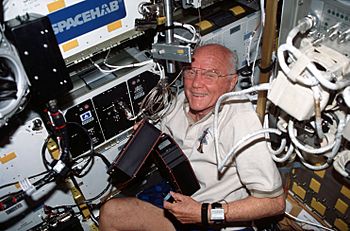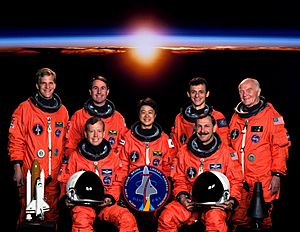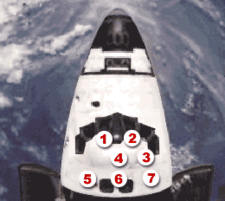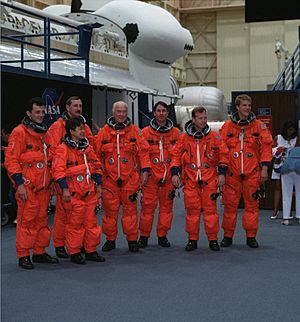STS-95 facts for kids

John Glenn in the Spacehab Single Module during flight
|
|
| Mission type | Bioscience research Astronomy |
|---|---|
| Operator | NASA |
| Mission duration | 9 days, 19 hours, 54 minutes, 2 seconds |
| Distance travelled | 5,800,000 kilometres (3,600,000 mi) |
| Spacecraft properties | |
| Spacecraft | Space Shuttle Discovery |
| Landing mass | 103,322 kilograms (227,786 lb) |
| Payload mass | 11,130 kilograms (24,540 lb) |
| Crew | |
| Crew size | 7 |
| Members |
|
| Start of mission | |
| Launch date | 29 October 1998, 19:19:34 UTC |
| Launch site | Kennedy LC-39B |
| End of mission | |
| Landing date | 7 November 1998, 17:04 UTC |
| Landing site | Kennedy SLF Runway 33 |
| Orbital parameters | |
| Reference system | Geocentric |
| Regime | Low Earth |
| Perigee | 550 kilometres (340 mi) |
| Apogee | 561 kilometres (349 mi) |
| Inclination | 28.45 degrees |
| Period | 96 min |
  Top: Parazynski, Robinson, Mukai, Duque, Glenn; Bottom: Lindsey, Brown |
|
'STS-95 was a Space Shuttle mission that launched from Kennedy Space Center, Florida, on October 29, 1998. The mission used the Space Shuttle Discovery. This was Discoverys 25th flight and the 92nd mission in the Space Shuttle program.
The mission gained a lot of attention because John Glenn, a former NASA astronaut and U.S. Senator, returned to space. At 77 years old, Glenn became the oldest person to go into space. This record stood for 23 years. Glenn, however, remains the oldest person to reach Earth orbit.
STS-95 was also the first time that HDTV was broadcast live across the U.S. from coast to coast. Another first for this mission was that Pedro Duque became the first person from Spain to travel into space.
The main goals of the mission were to study life sciences and astronomy. Scientists used a special module called SpaceHab to do experiments on Senator Glenn. They also wanted to learn more about the Sun and how it affects life on Earth. The crew released a spacecraft called Spartan 201, which flew freely to study the solar wind coming from the Sun's outer atmosphere, called the solar corona. The mission lasted almost ten days, with Discovery landing back at the Kennedy Space Center's Shuttle Landing Facility.
The weather for the launch was perfect, which is quite rare. Bill Clinton, who was the U.S. President at the time, watched the launch with his wife, Hillary. He was the second U.S. President to see a crewed space launch.
Contents
Meet the STS-95 Crew
The STS-95 mission had a crew of seven astronauts. Each person had an important role in the mission.
| Position | Astronaut | |
|---|---|---|
| Commander | Fifth spaceflight |
|
| Pilot | Second spaceflight |
|
| Mission Specialist 1 | First spaceflight |
|
| Mission Specialist 2 | Third spaceflight |
|
| Mission Specialist 3 | Second spaceflight |
|
| Payload Specialist 1 | Second and last spaceflight |
|
| Payload Specialist 2 | Second and last spaceflight |
|
Where Did the Crew Sit?
The astronauts had specific seats for launch and landing. Some seats were on the Flight Deck, which is like the cockpit. Others were on the Middeck, where the living and working areas are.
Key Mission Activities
The STS-95 mission had several important goals. These included doing science experiments, releasing a special satellite, and testing new equipment for the Hubble Space Telescope.
Spacehab Module for Experiments
The Spacehab module was a special pressurized room inside the Shuttle. It gave the astronauts more space to do experiments and store cargo. For STS-95, a single Spacehab module was placed in the front of Discovery's cargo bay. The crew could access it through a tunnel.
Many experiments were done in Spacehab. These were sponsored by NASA, the Japanese Space Agency (NASDA), and the European Space Agency (ESA). The experiments focused on life sciences, how things behave in microgravity (very low gravity), and new technologies.
Spartan Satellite: Studying the Sun
The Spartan 201-5 satellite was released and later brought back using the Shuttle's robotic arm. Spartan's job was to study the hot outer layers of the Sun's atmosphere, called the solar corona. It also measured the solar wind, which is a stream of particles from the Sun.
Scientists hoped the information from Spartan would help them understand solar winds better. Solar winds can affect satellites orbiting Earth and even weather conditions, which can impact TV and phone signals. This was Spartan's fifth flight. It had a problem on its previous mission, but it was fixed for STS-95.
HOST: Helping the Hubble Space Telescope
The Hubble Space Telescope Orbital Systems Test (HOST) platform carried experiments to test new parts. These parts were planned to be installed on the Hubble Space Telescope later. HOST also tested new technologies in space.
There were four experiments on the HOST platform. One tested a cooling system for a Hubble instrument. Another checked how a new computer for Hubble would react to radiation in space. A third compared a solid-state recorder in space to one on Hubble. Finally, a fiber optic line test checked data transmission.
IEH: International Extreme Ultraviolet Hitchhiker
The International Extreme Ultraviolet Hitchhiker (IEH) payload included several different experiments. These were mounted on a support structure in Discovery's cargo bay.
Some of the experiments on IEH included:
- Solar Extreme Ultraviolet Hitchhiker (SEH): Measured ultraviolet light from the Sun to study Earth's upper atmosphere.
- Ultraviolet Spectrograph Telescope for Astronomical Research (UVSTAR): Measured ultraviolet light to create images of plasma sources like Jupiter or hot stars.
- STAR-LITE: Observed large and spread-out objects in space.
- CONCAP-IV: Grew thin films using a special method.
- Petite Amateur Navy Satellite (PANSAT): A small satellite that stored and sent digital messages to ground stations.
- Getaway Special (GAS) payload: A small, self-contained experiment.
Medical Studies on John Glenn
John Glenn participated in STS-95 as a "human guinea pig" for studies on aging. These experiments were sponsored by NASA and the National Institute on Aging. Scientists noticed that the aging process and being in space cause similar changes in the human body. These changes include bone and muscle loss, balance problems, and sleep issues.
Researchers hoped that studying Glenn in space would help them understand aging better. Data from this mission was even compared to data from Glenn's first space flight in 1962, on Friendship 7.
Interesting Facts About STS-95
- John Glenn was the oldest person to fly in space at the time. He was also the third sitting member of the U.S. Congress to go to space.
- Just like during his first flight in 1962, the cities of Perth and Rockingham in Australia turned on their lights to greet Discovery as it passed overhead.
- STS-95 was the first mission where a Space Shuttle orbiter (Discovery) used NASA's "meatball" logo. This new logo replaced the "worm" logo that all Shuttles had before. Other Shuttles like Endeavour, Atlantis, and Columbia later got the "meatball" logo too.
Crew Recognition
The crew of STS-95 received the Douglas S. Morrow Public Outreach Award in 1999 from the Space Foundation. This award is given to people or groups who help the public learn more about space programs.
Minor Issues During the Mission
- The Shuttle's drag chute door fell off when the main engines started. Because of this, the crew decided not to use the drag chute during landing. The wheel brakes and speedbrakes were enough to stop Discovery safely.
- A small leak was seen from a thruster on the left side of the Shuttle. Astronauts used a valve to turn off that specific jet. The Shuttle has many other jets, so they could still control its position in space.
First HDTV Broadcast from Space
The launch of STS-95 was also special because it was the public launch of the American Advanced Television Systems Committee (ATSC) HDTV system. The live broadcast was sent across the U.S. and shown in science centers and other public places that had special equipment. This broadcast was made possible by the Harris Corporation. It was hosted by famous news anchor Walter Cronkite and former astronaut Pete Conrad.
Wake-up Songs for Astronauts
NASA has a tradition of playing music to wake up astronauts in space. This started during the Gemini program and was first used on Apollo 15. Each song is chosen carefully and often has a special meaning for an astronaut or relates to their mission.
| Flight Day | Song | Artist | Played for | Links |
|---|---|---|---|---|
| Day 2 | "What a Wonderful World" | Louis Armstrong | Scott Parazynski | WAV |
| Day 3 | "Cachito" | Nat King Cole | Pedro Duque | WAV |
| Day 4 | "This Pretty Planet" | Tom Chapin | Steven Lindsey | WAV |
| Day 4 | "Halelujahs" | Chris Rice | Steven Lindsey | WAV |
| Day 5 | "Moon River" | Andy Williams | John Glenn | WAV |
| Day 6 | "The House Is Rockin'" | Stevie Ray Vaughan | Steve Robinson | WAV |
| Day 7 | "Wakaki Chi" ("Young Spirit") | Keio University "cheering song" | Chiaki Mukai | WAV |
| Day 8 | "I Know You're Out There Somewhere" | The Moody Blues | Curtis Brown | WAV |
| Day 9 | "Voyage into Space" | Peter Nero | John Glenn | WAV |
| Day 10 | "La Cucaracha" | Pedro Duque | WAV |
Mission Patch Design
The STS-95 mission patch was designed by the crew. It shows the science, engineering, and history of the flight. The blue Space Shuttle has yellow, red, and blue streamers coming from it. These streamers represent the benefits of the mission's science experiments and the solar studies.
A small Mercury space capsule is shown orbiting the Shuttle. The red streamer goes up to form a "7" in the center of the Shuttle. The capsule and the number seven refer to John Glenn's connection to the Mercury Seven astronauts. All their Mercury spacecraft had "7" in their names. The patch also shows symbols for the mission's main scientific areas: microgravity material science, medical research, and astronomy.
Images for kids
See also
 In Spanish: STS-95 para niños
In Spanish: STS-95 para niños





